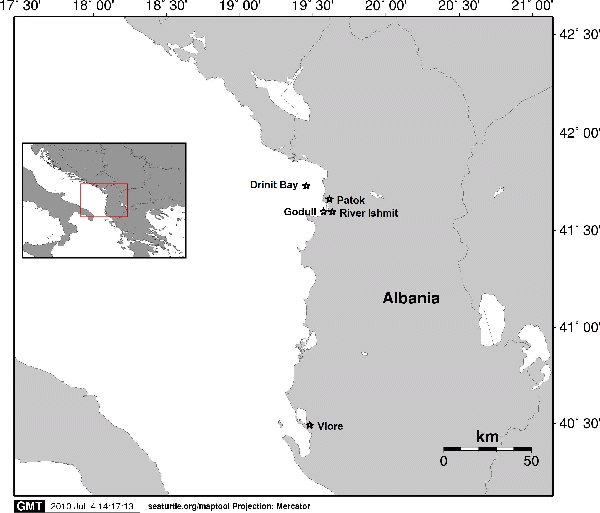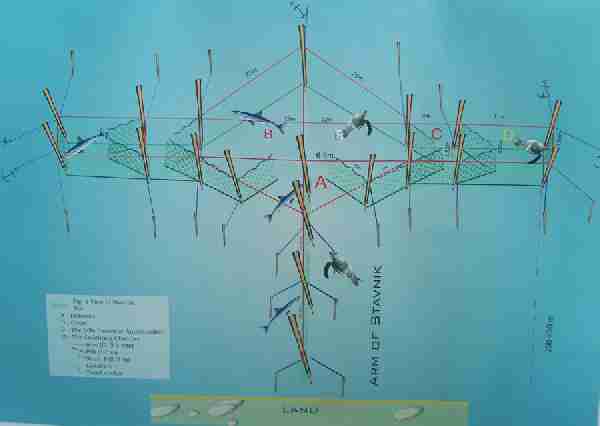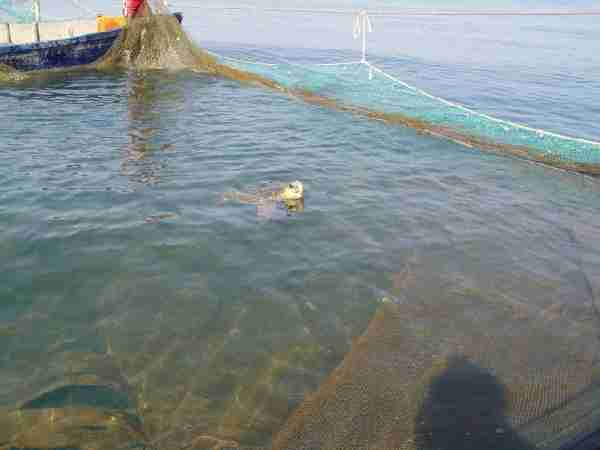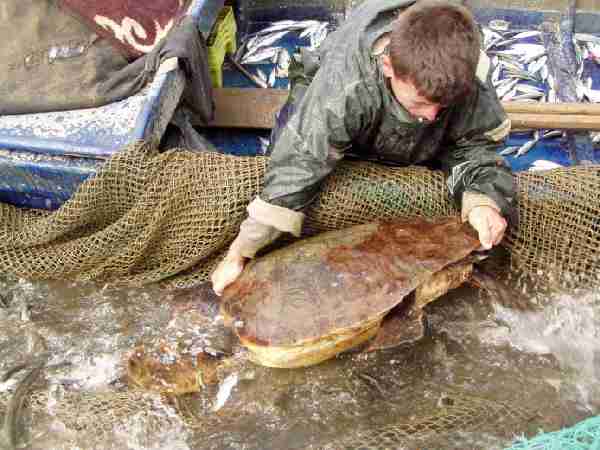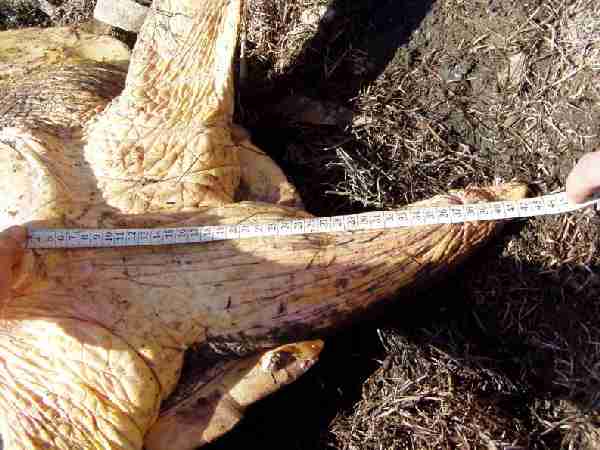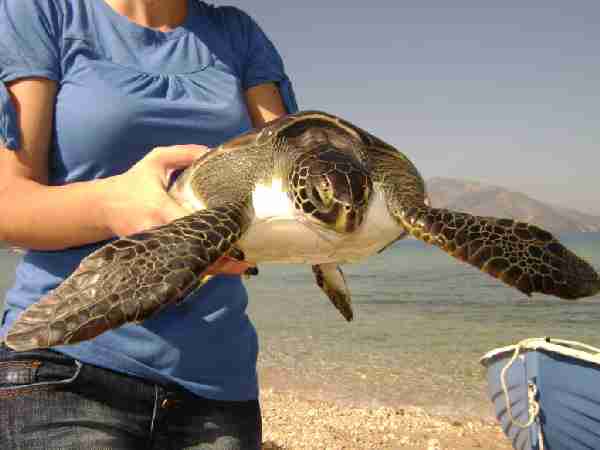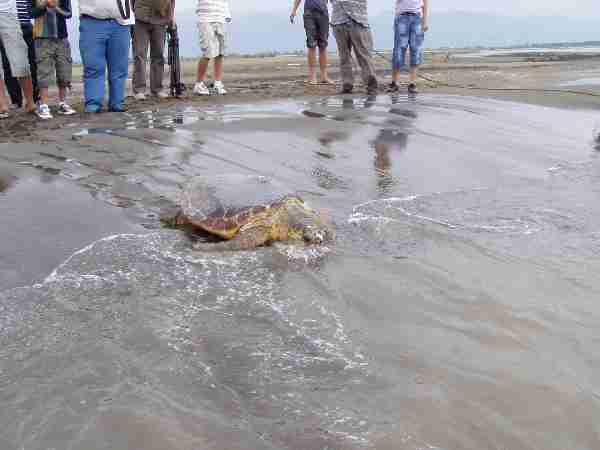Michael White, Liza Boura and Lily Venizelos
MEDASSET – Mediterranean Association to Save the Sea Turtles
Background
In October-November 2005, in order to determine the presence and distribution of sea turtles and Mediterranean monk seals in Albania, MEDASSET conducted a yacht-based survey of Albania’s nearshore coastal waters (White et al., 2006), in collaboration with the University of Tirana, the Albanian Port Authorities and the Albanian Ministry of Environment. This voyage included some ground-breaking research: we devised a novel system to conduct transects underwater using SCUBA divers to determine turtle population density. Unfortunately this failed, as visibility at most dive sites was zero. We found no evidence of seals, although every suitable cave was examined for signs of their presence. Students from the Hydrobiology Course at Tirana University were taken to sea on different days and shown how we conducted our research. Throughout this voyage fishermen at each port were interviewed about their turtle bycatch and sightings: the largest numbers of turtles were reported from Drinit Bay in Northern Albania (N41°38’; E019°35’). Fewer turtles were reported in other parts of Albania, although still present as bycatch. This assessment laid the groundwork for the current project: ‘Monitoring and Conservation of Important Sea Turtle Feeding Grounds in the Patok Area of Albania 2008-10’.
The Patoku Sea Turtle Project
In 2008, within the framework of MEDASSET’s sea turtle conservation programmes in the Mediterranean, the above three-year research project was launched in association with Tirana University and the Albanian Herpetofauna Society. The long-term aim of this project is for the Patok area to be recognised as a nationally and regionally important foraging habitat for sea turtles in the Mediterranean and that these endangered species are fully protected under Albanian national law.
A field base was established at Patoku in June 2008 by the lead author to monitor turtles captured incidentally (bycatch) by artisanal fishermen. The general area consists of a very shallow lagoon, some wetlands, and then a shallow bay. Drinit Bay is a shallow sea (maximum depth in the survey area is 47m) with a sand/mud substratum dominated by bivalves and crabs. Extensive fishing occurs throughout the bay (Fig. 1), which is about 30km north to south, with artisanal fishing being the main economic activity.
Fig. 1. Map showing Drinit Bay. Compiled using the Maptool Programme. (Maptool is a product of Seaturtle.org)
Almost all of the turtles studied were caught as bycatch in ‘stavnike’ fish-traps (White et al., 2008). Stavnikes (Fig. 2) originated in Russia, and are constructed by forcing long poles into the sandy seabed in shallow water (usually 6-8m depth); a system of nets is then attached to the posts forming a large rectangle (typically 90 × 10m), with a barrier-net extended towards the shore (one set of traps was nearly 2km offshore). When animals encounter the barrier-net they have three choices: to head towards the beach into very shallow water, to return the way they came (an area that they may have just foraged in), or to enter the traps. Stavnikes appear to be non-lethal for turtles, as they are able to swim around, and, crucially, surface to breathe normally (Fig. 3).
Fig. 2. Stavnike design fish trap. © Prof. I. Haxhiu.
Fig. 3. Loggerhead turtle Caretta caretta surfacing within a stavnike. Photos © Medasset.
The traps are emptied each morning using small flat-bottomed boats (Fig. 4); fish-catch was monitored by the research team to see if there might be a correlation between the catch and the presence of turtles (e.g. medusae or crabs might attract foraging sea turtles). The project paid for the fishermen’s fuel costs to transport ashore the turtles found in the stavnikes so that the research team could study them and collect data. Researchers have slowly built a good working relationship with the fishermen and the local communities, in what is an isolated and impoverished part of Albania. Data collected (White et al., 2009) include turtle measurements (Fig. 5), sex, life-stage, the presence of epibiota (commensal organisms such as barnacles) and physical condition (injuries and health assessment).
Fig. 4. A loggerhead turtle being lifted from the stavnike.
Fig. 5. Measuring the tail of an adult male loggerhead.
In 2009, sea turtle monitoring continued from June to September with the emphasis of the project shifting towards capacity-building. Seven students from the School of Biology, Tirana University, were trained successfully as Research Assistants (RAs). The Project pays each RA a small daily field allowance, and covers their food and accommodation; this is important because otherwise the students would be unable to participate as they have no other income. The research training programme included: animal-handling skills; morphometrics (how to measure turtles); the importance of accurate data-collection; the correct application of tags; the use of photo-recognition (Fig. 6), a technique developed as a method of identifying individual animals at sea (White, 2007) which has been used successfully at Patoku to overcome the problem of tag loss; identifying fish species; and recording abiotic factors, such as sea temperature and wind speed. These practical skills were underpinned by lectures on sea turtle biology and ecology, and the impacts of human activities on endangered species and the marine environment.
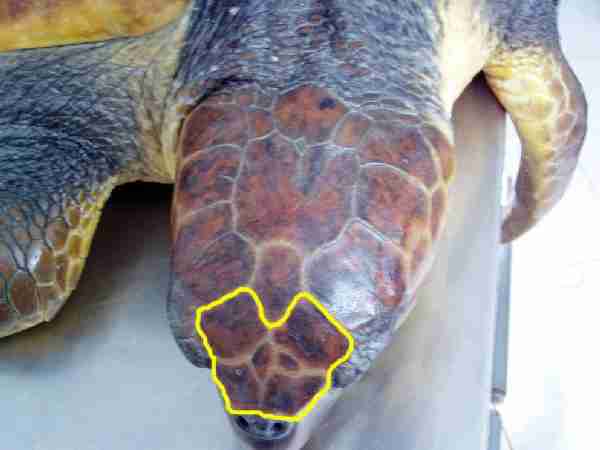
Fig. 6. Head scales used in photo-recognition.
As part of a regional attempt to understand sea turtle populations in the Mediterranean, the lead author collected skin samples from 28 loggerheads for DNA analysis that was carried out by the laboratory of Dr Oguz Turkozan at Adnan Menderes University, Turkey. This study is planned to continue in 2010, and is expected to provide better insight into the foraging behaviour and migratory patterns of sea turtles in the eastern Mediterranean.
Since 2008, the project has also provided an opportunity for tertiary-level students to attend field days at Patoku, where various aspects of turtle biology and ecology, the importance of our research programme and the impacts of anthropogenic activities are demonstrated. Project outreach activities have been considerable since its launch: the project has been included in numerous national television programmes and Albanian newspaper articles, delivering the message of the need for sea turtle protection nationwide.
Key findings
- Over the two summers of 2008-2009 we measured and tagged over 245 loggerheads (Caretta caretta) providing evidence that this is a significant foraging area for sea turtles. They were allocated into 10-cm size-classes based on their curved carapace length (CCL). The mean CCL of the 211 turtles1 measured was 64.0cm and SD (standard deviation) was 8.6cm. One green turtle (Chelonia mydas) was tagged. Green turtles are only found in small numbers outside the tropics: there is a small nesting population in the north-eastern Mediterranean (Cyprus, Turkey, and Levant), so making such a find in Albania (Fig. 7) is important, as it widens our knowledge of this species’ foraging distribution. In the autumn of 2009 another green turtle was caught in a gill-net at Vlore, Albania.
Fig. 7. Green turtle Chelonia mydas found at Orikum, Albania.
- When previously-tagged turtles are found in the stavnikes, we use their tag-data to tell us when they were tagged originally and the length of time between captures. Their morphometric data allow us to calculate growth-rate between captures. A very important research result is that a small number of turtles (n = 21) were recaptured in the Drinit Bay area in years subsequent to their initial capture. Interestingly, all remigrants were originally tagged at Drinit; there were no tags from elsewhere. This suggests that Drinit Bay forms part of a succession of marine habitats for loggerheads (and perhaps greens).
- Some turtles were recaptured within the same year indicating that they may remain foraging locally for several weeks. In 2008 there were 23 such incidents and in 2009 another 10. One loggerhead was recaptured five times in two months (2008), which suggests that entrapped turtles were not deterred from foraging locally, despite being manhandled out of the nets and then being landed for measuring and tagging.
- Male turtles, identified from their tail measurements (Casale et al., 2005; White et al., 2008; 2010a), form a substantial proportion of the bycatch (23 adults and 43 adolescents; 27%; White et al., 2008; 2010a); this is an important finding because our scientific knowledge of males is sparse compared with our extensive knowledge of reproductive females and their nesting beaches. Incidentally, nesting has not been reported from Albania, and so this assemblage of males is unusual (White et al., 2010a). This discovery has increased importance also because of the threatened impact of global climate change, which may force embryonic sex-ratios of turtles towards female-dominance. Amongst the male population six adults and two adolescents had been captured at Patoku in more than one year (remigrants). Intra-annual recaptures included three adult and four adolescent males demonstrating at least short-term site-fidelity.
- Marine habitat use by turtles is still poorly understood (Limpus & Limpus, 2003; White, 2007). Turtles are known to migrate into, or forage within, the Adriatic Sea (Lazar et al., 2000; 2004; Margaritoulis et al., 2003; Zbinden et al., 2008) which means they must pass through either Italian or Albanian waters en route from the Ionian Sea. During the winter months the stavnikes are dismantled and the Patoku fishermen move into the sheltered inner lagoons to catch eels. This means that there are very few data available over this period; so we do not know if turtles remain in Drinit Bay year-round, or if they migrate southwards into warmer waters. Therefore, in September 2009, satellite transmitters were deployed onto three loggerheads in a bid to answer these questions (Fig. 8). This study is expected to last until September 2011; to date our female telemetered turtle, Shpresa (Hope), seems to have remained at Patoku and the two males have moved elsewhere: Guximtari (Brave) northwards to Croatia, and Patoku southwards to Kerkyra (Corfu, Greece). Updated migration routes and current positions of the three tracked turtles can be viewed and followed on the webpage ‘Turtle Tracking’ at www.medasset.org and at http://www.seaturtle.org/tracking/?project_id=445. Patoku has recently returned to the broader area of Drinit Bay, arriving in early May.
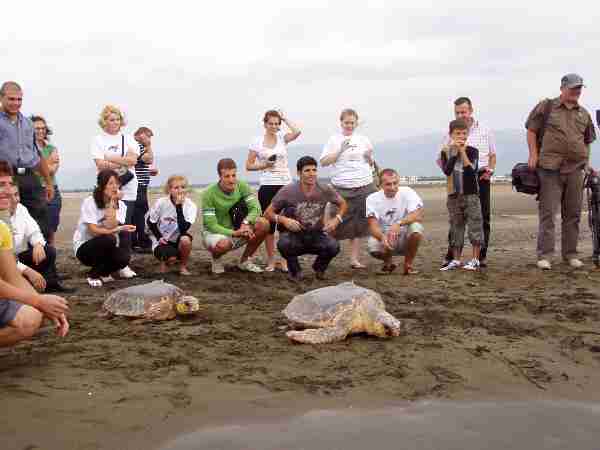
Fig. 8, a) and b). Release of the turtles fitted with transmitters.
Anthropogenic debris
Vast amounts of garbage (Fig. 9) were observed on all beaches throughout Drinit Bay. A simple means of quantifying the debris by using a series of comparative quadrats at eleven different sites was devised (White et al., 2010b). Items counted in each quadrat (10 × 10m) were allocated into categories, such as plastic, clothing, glass or organic materials. The worst-affected areas were at Godull (1095 items) and at the mouth of Ishmit River (1595 items); 90% of these items were plastic. At present the impact of this debris on turtles in Albania is unclear. A recent five-year study of turtle faeces at Centro Recupero Tartarughe Marine, Lampedusa shows that 60% of their hospitalised turtles had consumed anthropogenic debris, mostly plastics (Freggi et al., 2010). We had no facility at Patoku where turtles could be kept for several days until a faecal sample was obtained. So it seems highly likely that the omnivorous loggerhead turtle will eat at least some of the widespread debris in Drinit Bay.
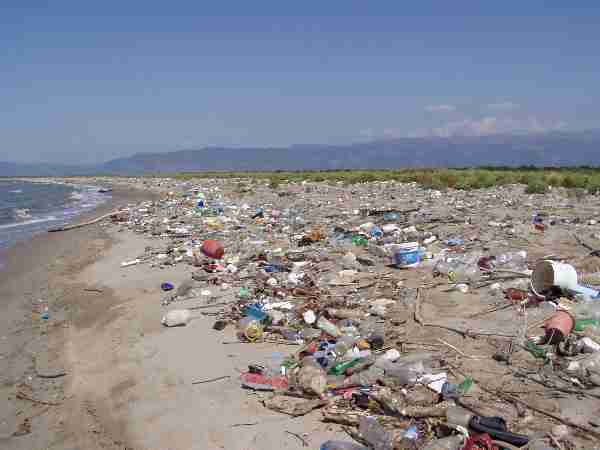
Fig. 9. Pollution at Godull Beach.
The project in 2010
In 2010, the final year of the project, launched by the UN as International Year of Biodiversity, MEDASSET will continue data collection and capacity building activities and will focus on providing recommendations to the Albanian authorities in order to conserve Albania’s fragile biodiversity and protect the sea turtles visiting its seas. Monitoring for a third year will help to scientifically determine and further corroborate the ecological importance of the area. Continued research in 2010 should allow the clarification of the foraging population structure at Patoku, the identification of other remigrants, reveal any repeat migration and also show if either previous year was atypical. Through the educational activities, the project will build the capacity and provide the necessary training for the younger generation, environmental organisations and the local community, to monitor and protect sea turtles and the rich marine biodiversity of Patok in the future.
Conclusions
The long-term aim of this project is for Albania to become self-sustaining in terms of its sea turtle research and conservation. MEDASSET has made a substantial contribution in building capacity in this impoverished country. Of particular importance is the fact that three girls were trained as Research Assistants: a significant milestone in the patriarchal culture of Albania.
Research results so far are reinforcing our view that the Patok area of Albania is an important feeding ground for sea turtles in the Mediterranean (White et al., 2010c).
Acknowledgements
The 2005 project ‘Rapid Assessment Survey of important marine turtle and monk seal habitats in the coastal area of Albania’ was funded by the Regional Activity Centre for Specially Protected Areas (RAC/SPA) of UNEP/MAP (United Nations Environment Programme-Mediterranean Action Plan), MEDASSET and the Global Environment Facility’s Small Grant Programme (GEF/SGP). The research boat was provided by Vernicos Yachts. ‘Monitoring and Conservation of Important Sea Turtle Feeding Grounds in the Patok Area of Albania’ in 2008 was developed by MEDASSET in collaboration with ECAT Tirana (Environmental Centre for Administration and Technology) and the University of Tirana. It was endorsed by the Albanian Ministry of Environment, Forest and Water Administration. Co-funding was provided by MEDASSET, GEF/SGP and RAC/SPA. The 2009 phase was developed by MEDASSET in collaboration with the University of Tirana and the Albanian Herpetofauna Society. Co-funding was granted by GEF/SGP, MEDASSET, RAC/SPA, UNEP/MAP and the British Chelonia Group (BCG). We warmly thank Dr Oguz Turkozan and Adnan Menderes University, Turkey for the free analysis of the DNA samples collected in 2009. We are also grateful to the BCG for the renewed financial support towards the final year of the project in 2010.
References
Casale, P., Freggi, D., Basso, R. & Argano, R. (2005). Size at male maturity, sexing methods and adult sex ratio in loggerhead turtles (Caretta caretta) from Italian waters investigated through tail measurements. Herpetological Journal 15: 145-148.
Freggi, D., D’Addario, M., Cina, A. & Milluzzo, D. (2010). Anthropogenic materials expelled by Caretta caretta as an indicator of human environmental impacts. 30th International Sea Turtle Symposium, 27-30 April 2010, Goa, India.
Lazar, B., Margaritoulis, D. & Tvrtkovic, N. (2000). Migrations of the loggerhead sea turtle Caretta caretta into the Adriatic Sea. In: Abreu-Grobois, F.A., Briseno-Duenas, R., Marquez, R. & Sarti, L. (compilers) (2000). Proceedings of the 18th International Symposium on Sea Turtle Biology and Conservation. NOAA Technical Memorandum NMFS-SEFSC-436, pp. 101-102.
Lazar, B., Margaritoulis, D. & Tvrtkovic, N. (2004). Tag recoveries of the loggerhead sea turtle Caretta caretta in the eastern Adriatic Sea: implications for conservation. Journal of the Marine Biological Association of the United Kingdom 84: 475-480.
Limpus, C.J. & Limpus, D.J. (2003). Biology of the loggerhead turtle in Western South Pacific Ocean foraging areas. In: Bolten, A.B. & Witherington, B.E. (eds). Loggerhead sea turtles. Smithsonian Books, Washington D.C. pp. 93-113.
Margaritoulis, D., Argano, R., Baran, I., Bentivegna, F., Bradai, M.N , Caminas, J.A., Casale, P., de Metrio, G., Demetropoulos, A., Gerosa, G., Godley, B. J., Haddoud, D.A., Houghton, J., Laurent, L. & Lazar, B. (2003). Loggerhead Turtles in the Mediterranean Sea: Present Knowledge and Conservation Perspectives. In: Bolten, A.B. & Witherington, B.E. (eds), Loggerhead Sea Turtles. Smithsonian Books, Washington D.C. pp. 175-198.
White, M., Haxhiu, I., Kouroutos, V., Gace, A., Vaso, A., Beqiraj, S. & Plytas, A. (2006). Rapid assessment survey of important marine turtle and monk seal habitats in the coastal area of Albania, October-November 2005. Available from www.medasset.org
White, M.G. (2007). Marine ecology of loggerhead sea turtles Caretta caretta (Linnaeus 1758) in the Ionian Sea: Observations from Kefalonia and Lampedusa. PhD thesis, University College Cork, Ireland.
White, M., Haxhiu, I., Saçdanaku, E., Petri, L., Rumano, M., Osmani, F., Vrenozi, B., Robinson, P., Kouris, S. & Venizelos, L. (2008). Monitoring stavnike fish-traps and sea turtle bycatch at Patoku, Albania. International Conference on Biological and Environmental Sciences, Faculty of Natural Sciences, Tirana University, Tirana, Albania, pp. 404-409.
White, M., Haxhiu, I., Saçdanaku, E., Petri, L., Rumano, M., Osmani, F., Vrenozi, B., Robinson, P., Kouris, S., Boura, L. & Venizelos, L. (2009). Monitoring and Conservation of Important Sea Turtle Feeding Grounds in the Patok Area of Albania. 2008 Project Report. Available from www.medasset.org
White, M., Haxhiu, I., Boura, L., Gërdeci, X., Kararaj, E., Mitro, M., Petri, L., Përkeqi, D., Robinson, P., Rumano, M., Saçdanaku, E., Trezhnjevna, B., Vrenozi, B. & Venizelos, L. (2010a). Male loggerheads at a foraging & developmental habitat in Albania. 30th International Sea Turtle Symposium, 27-30 April 2010, Goa, India.
White, M., Haxhiu, I., Kararaj, E., Përkeqi, D., Petri, L., Saçdanaku, E., Boura, L. & Venizelos, L. (2010b). Plastic debris at an important sea turtle foraging ground in Albania. 30th International Sea Turtle Symposium, 27-30 April 2010, Goa, India.
White, M., Haxhiu, I., Gërdeci, X., Kararaj, E., Mitro, M., Petri, L., Përkeqi, D., Saçdanaku, E., Trezhnjevna, B., Rumano, M., Vrenozi, B., Boura, L., Grimanis, K., Robinson, P. & Venizelos, L. (2010c). Monitoring and Conservation of Important Sea Turtle Feeding Grounds in the Patok Area of Albania. 2009 Project Report. Available from www.medasset.org
Zbinden, J.A., Aebischer, A., Margaritoulis, D. & Arlettaz, R. (2008). Important areas at sea for adult loggerhead sea turtles in the Mediterranean Sea: satellite tracking corroborates findings from potentially biased sources. Marine Biology 153(5): 899-906.
1 Some turtles were data-deficient because parts of the carapace were damaged and true measurements could not be taken.
Testudo Volume Seven Number Two 2010
Top

